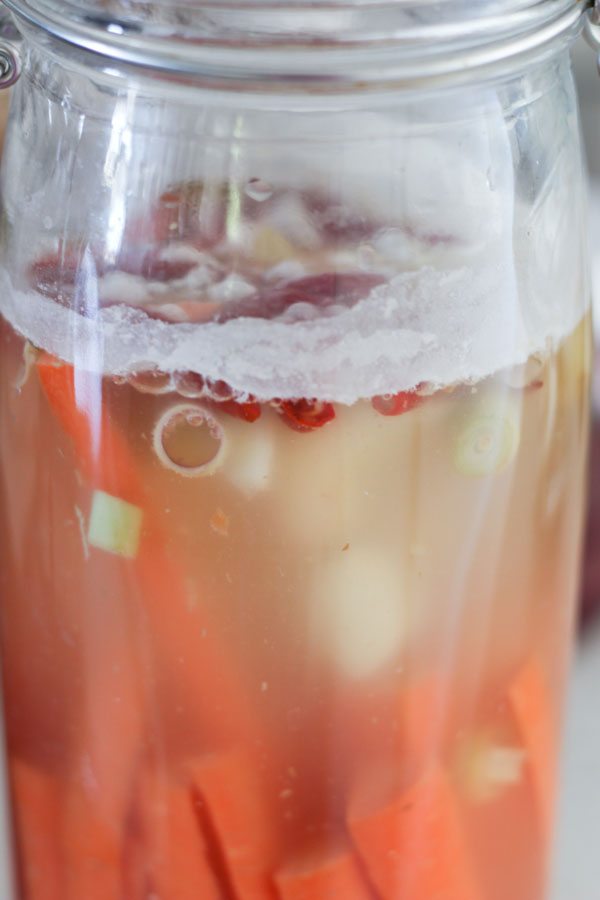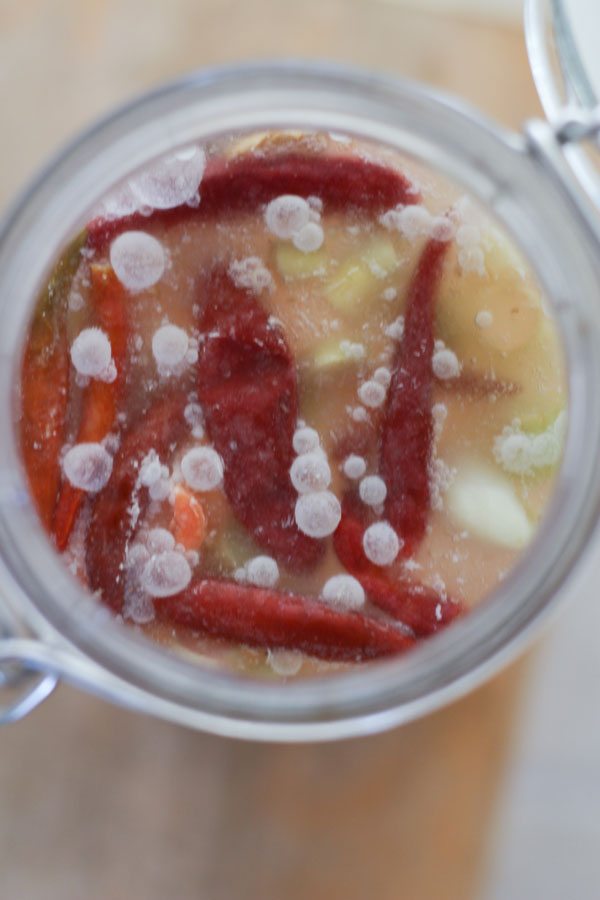So, what is that white milky on my fermented veggies? Occasionally when I make fermented vegetables a white milky substance forms on the top of the pickle brine. If this happens to you…don’t freak out.
I recently made a big batch of fermented carrots and 2 days into fermenting them a white milky substance formed on the surface of the brine. I thought it would be a good opportunity to take some pictures and share with you in case you run into this problem. I’ve had readers reach out to me via email about this too so I want to address it.
Don’t worry. It’s not mold and it’s not harmful.
Most people immediately think it’s mold and throw the whole batch away. Mold is circular, fuzzy, white and bluish.
What is it
The white milky substance that commonly appears on the surface of fermented vegetables is kahm yeast. It’s a type of wild yeast and it’s not harmful. It’s not very attractive and it can cause a bad odor if left alone. If you see this appear, skim the kahm yeast off the surface. Don’t worry if you can’t get it all. It won’t hurt you.
Fermented vegetables have a pleasant sour smell, but if they smell rotten or rancid then the batch went bad and you should throw it out and start a new one.
Why it happened
Kahm yeast can appear for many reasons. During the summer months the most common are warm temperatures. Other reasons are…
- Not enough salt added to the brine.
- Warmer than average temperatures.
- If the vegetables are not fresh than kahm yeast can appear.
- Cleanliness when preparing the vegetables. Make sure your jars, equipment and hands are washed thoroughly.
What to do about it
Don’t throw your fermented vegetables away if kahm yeast appears. Just skim it off the top. Remember that everything is fine under the brine. The brine creates an anaerobic environment that mold can’t live in.
I hope this helps and prevents you from throwing out a batch of perfectly good fermented vegetables. Have you experienced kahm yeast on your fermented vegetables? What did you do about it?
One more thing…have you experienced any other weird things when fermenting vegetables, like white foam on top, surface mold or strong smells?
Have a great day and please share with your friends and family if you think they would benefit from this advice.


I had a big batch of fermented carrots and cauliflower that developed a bad case of Kahm. I thought it was mold. It stank pretty bad and got deep into the batch (turned out I didn’t compress the veggies very well) so I tossed the whole thing. Then I learned about Kahm. Recently had another batch develop a top layer of it. Scraped it off, removed some of the top layer of veggies, and the rest is good to eat.
I have a batch of pickles. I noticed very slight kahn yeast on top which I skimmed off, but on closer inspection, the pickles have a white film on them as well. It doesn’t smell bad, and I tasted a pickle, and it tasted fine. Are the pickles with white film on them salvageable?
Yes, that’s normal and they are fine.
Is this normal on fermented ghost pepper mash? Any help would be appreciated.
https://uploads.disquscdn.com/images/0ffe04601ff0378f0fb8a748188e341c62cdc1530b2e34ab5e86ceaf0b7afb57.jpg
Yeah it can happen on any fermented vegetable.
Ok, thank you. This is my first batch so I wasn’t sure. Being that this is a mash I am not able to weigh it down so I am using an airlock. Is the the correct process?
Yes, an airlock is a great tool to prevent mold. Yeah, you can’t really weigh down a mash.
I have a white film that looks like it has “snowed” on my jalapenos and is accumulating on the bottom of the jar . Is this normal?
Yes, it’s the yeast.
There is quite a bit of it and I fear it will affect the flavor. Do you reccomend just leaving it? What about rinsing them and repacking?
This happened to me with my very first attempt at lacto-fermenting carrots with garlic, rosemary and chili flakes (I used whey from homemade yogurt)! Even after discovering it was Kahm yeast and not anything dangerous I was still really nervous. It sat on coffee table an extra week just because I didn’t want to touch it. I read your article and it gave me courage to deal with it. I opened the jar, smelled it. I could smell a little yeastiness but I could also smell a delicious tangy scent. I took the top layer off and then decided to dump the brine out completely (sorry still nervous). I made a fresh brine (another site recommended transferring it to fresh brine in case the smell takes over) and rinsed the veggies and then put them in a new jar and added the brine. It’s in the fridge now. I tasted a few carrots and a piece of garlic and it was delicious.
I am a little worried about rinsing off good bacteria, but I think since it’s my first attempt, I’ll live with that. At least the flavor is perfect!
Now, I’ll wait and see if I get food poisoning. :P
Wow that is happening to me as well but with my ginger ale. I make my syrup then I put my bug then the next day it will have a thin white powdery film on the top what can I do to stop it it’s never done it before I don’t know if it’s from my bug or what can you please help me
Just skimmed my gallon jar of cukes. Never bothered me. I love to drink the yeast that accumulates in my home brew. Mold is pretty obvious.
I have seen the kham yeast several times and took it as a pellicle which is a carbohydrate by-product of a brettanomyces ferment in beer. Being brettanomyces is present on all veg and fruit it made sense. Thoughts? Looks exactly the same.
Also, just cracked a jar if three month old lemons in brine and found a strong ammonia smell. There was also a white sludge like formation in the brine, which surprised me. I added filtered water and refrigerated the food to see what your thoughts were. The lemons look.yellow and beautiful…
All insights appreciated!
Dave